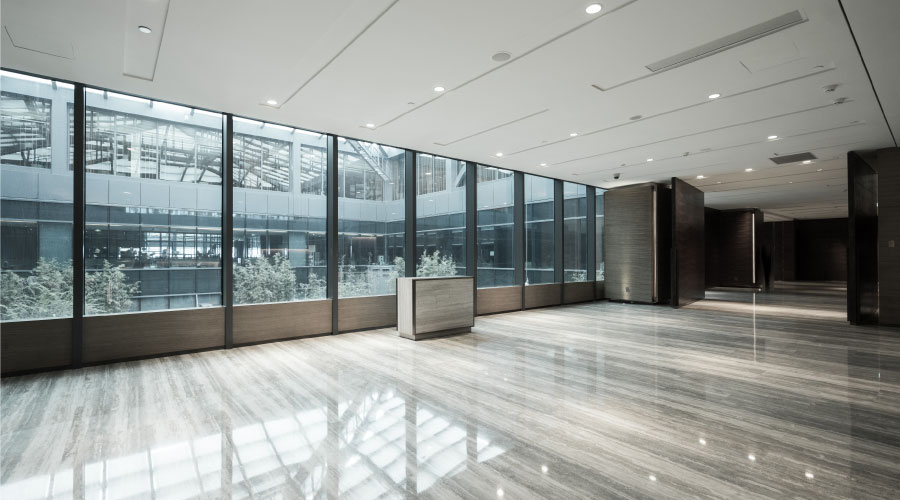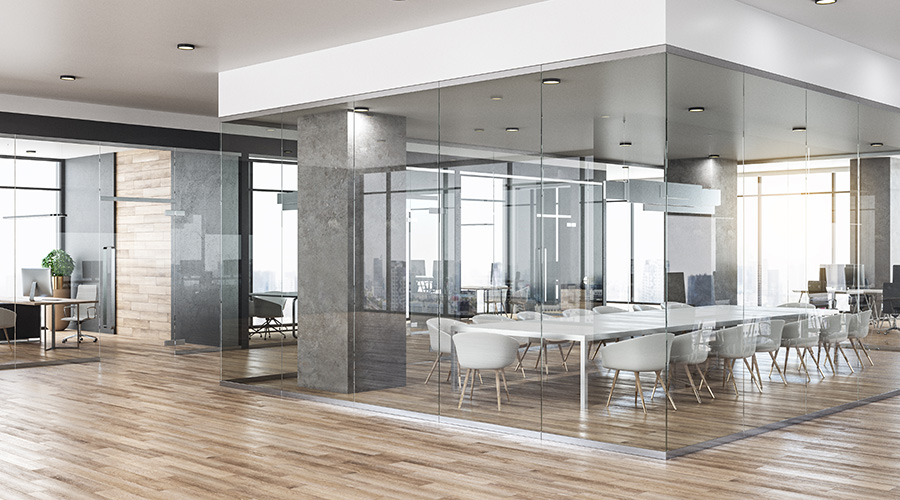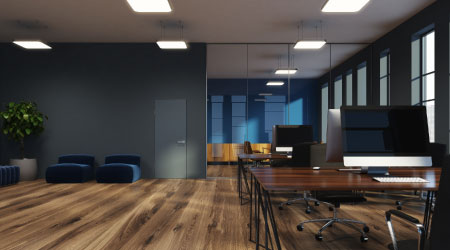Innovations offer more choices for facility executives
By Lacey Muszynski, Assistant Editor
Vinyl flooring has been popular since its creation in the 1930s. Familiar, durable and attractive, vinyl is a favorite used in many different types of facilities, especially educational, health care and retail.
As popular as vinyl is, however, facility executives shouldn’t choose a floorcovering without taking a look at the full range of resilient and hard surface flooring options available today. Each product has advantages and limitations that should be weighed along with factors such as cost, maintenance requirements and aesthetics. The best way for facility executives to find the right flooring option is to consider all those factors with respect to criteria for the space in which the flooring will be installed.
Narrowing the Field
Selecting a flooring product that’s best for a space involves — in a nutshell — knowing the space. Occupants and the tasks that they will be performing dictate the appropriate flooring choice. What works in a retail fitting room may not work well in a busy restaurant, for example. Both spaces have different functions, traffic loads and patterns, maintenance issues and, chances are, budget. “In an operating room where hygiene is important, a facility executive wouldn’t use a tile product,” says Dominic Rice, vice president, product management – commercial resilient flooring, Armstrong. “You need a sheet product with heat welded seams.”
Top on most facility executives’ lists of considerations for choosing flooring is budget. For this reason, flooring such as vinyl composition tile (VCT) is often used in schools where budgets are usually tight. VCT is usually recognized as the least expensive flooring option in terms of first cost.
However, life-cycle costs should be considered as well as first costs. By simply choosing the flooring with the lowest price tag, a facility executive may be costing the facility more money in the long run on replacement and maintenance costs.
In general, resilient flooring is becoming easier to maintain and install, says Kevin Jeon, general manager, LG Floors. “Flooring that’s simple to maintain and install adds to the cost-effectiveness for the end user.”
The next most frequently considered factor involved in flooring is aesthetics, which is often in conflict with budget. Sometimes, the best looking flooring choice will be the most expensive. However, there are products on the market, such as luxury vinyl tile (LVT) and high-pressure laminates, which give a realistic, interesting visual while still being more cost-effective and durable than the actual natural material. Some manufacturers emboss the surface of the product, creating an even more detailed and realistic look of wood, stone or metal for a much lower price tag.
Resilient and hard surface flooring products are also available that incorporate custom colors or logos. Tiles can be custom-cut and laid out in almost any shape. Custom visuals like this are often used in retail settings and corporate facility entrances where a company wants to make a big splash with visitors or employees.
Durability concerns must be addressed before a facility executive can decide on a flooring product. This relates directly back to how the space will be used. In high-traffic areas where wear and tear is a concern, resilient flooring, including various types of vinyl and rubber, should be considered. Sheet vinyl will withstand rolling loads more readily than vinyl tiles, and rubber is a good choice where occupant comfort or non-slip issues are a concern.
Other factors regarding the durability and use of a floor include safety (will the occupants need something with slip-resistance?), traffic patterns (is this in a high-traffic hallway or a seldom-used office?), hygiene (is this an operating room or pharmaceutical manufacturer?) and UV-protection (will this flooring be subjected to bright sunlight on a regular basis?).
Decisions, Decisions
Options for resilient and hard surface flooring abound.
High-pressure laminate is made with component layers of kraft paper around a high-density fiberboard core, bonded together with adhesive. The surface of the product includes a decorative sheet — the flooring’s pattern — and wear layer for durability. This sandwich of materials is heated while being pressed at around 1,400 psi, creating a high-pressure laminate in plank or tile form, says Randy Philips, national sales manager for commercial flooring, Wilsonart.
High-pressure laminate flooring tends to have low installation costs. Unlike vinyl, high-pressure laminate is not attached to the subfloor. “Laminate is a floating floor,” says Philips. “It just lays on the subfloor. We glue the floor together but we don’t glue it down. It just floats on top of the underlayment.” Because of this, high-pressure laminate can be installed over most existing subfloors. This means in most cases, a facility executive doesn’t have to pay contractors to remove the floor in a remodel or renovation project.
And because of the way high-pressure laminate is installed, occupants can be back on the floor within an hour of installation, says Philips.
At least one high-pressure laminate manufacturer is developing a melamine overlay impregnated with aluminum oxide particles. This will give the flooring better performance over time and increase the clarity to the pattern.
Linoleum has been gaining popularity in recent years because of the increasing interest in green buildings and products. “The key to linoleum is the materials it’s made from,” says Rice. “It serves the same purpose as vinyl, but it can be used where sustainable products are of interest to the customer.”
It is manufactured using wood pulp, cork powder, limestone, linseed oil, pine resin and mineral pigments which are rolled out and applied to a jute backing. The flooring is then cured in ovens for 14 to 21 days. Like vinyl, it is offered in a wide range of colors and patterns. Linoleum also offers natural anti-bacterial properties and biodegradability, but must be polished to build up a protective coat against staining.
In the past, rubber flooring has traditionally been installed in back-of-the-house areas where safety and performance features outweigh the typical raised-button look of older rubber floors, says Rachel Tipton, communications specialist, Johnsonite. “In public areas where rubber’s performance could deliver a better return, it’s been abandoned for aesthetic reasons alone.”
Rubber manufacturers are addressing that problem head-on and are developing myriad colors and textures, other than the old-fashioned raised-button or square look. Because of these new design elements, the longevity of the product, sound dampening characteristics and comfort underfoot, the use of rubber in all areas of a facility is growing.
A surprising new location for rubber flooring is in commercial kitchens. In the past, rubber hasn’t been appropriate for use in kitchens where animal fats and oils are present because the rubber absorbs these materials. Recently, however, manufacturers have been creating new lines of rubber that resist oils and fats, as well as harsh chemicals. Rubber’s inherent slip-resistance is also well-suited to a kitchen environment, where spills are commonplace. It’s also naturally resistant to mold and bacteria, making it a hygienic choice for commercial kitchens or other warm environments where moisture is a concern.
Rubber flooring is also latex-free, non-porous and can be cleaned with water or a neutral-pH cleaner, says Tipton.
Cork flooring, like linoleum, is made from sustainable and renewable materials and is going through a bit of a renaissance. Designers and facility executives are rediscovering cork flooring, and it’s coming back in style with new brighter colors and richer natural tones.
Cork is made from the bark of the cork oak. The bark is peeled away, leaving the tree and inner bark intact, which will form the base layer for the next growth cycle. The bark, processed and combined with resins, is baked into blocks and sliced into tiles. The longer it bakes, the darker the natural color becomes.
Tiles can be waxed or unwaxed. With either option, the floor still needs to be treated similar to a wood floor and coated with polyurethane. Maintenance is also similar to urethane-coated wood. Cork can be vacuumed and damp-mopped with a mild detergent.
Visually, the size of the bark granules determines the aesthetic. Finely-ground bark results in a non-directional, even grain, while highly-burled bark creates a large grain. Cork is soft and comfortable underfoot, warm, naturally slip-retardant and acts as a sound dampener.
Last But Not Least…
Vinyl flooring can sometimes conjure hesitation in building occupants’ minds because of experience with other vinyl products. “Sometimes people have the wrong impression of vinyl, and it turns them off,” says David Voll, senior marketing manager, Amtico. “There’s an ongoing debate in the facilities world because so many things — sometimes things that wouldn’t have good flooring properties — are made from vinyl.”
Regardless of any misconceptions, vinyl flooring is still the most commonly used resilient floor. It’s available in tile, plank and sheet form and is usually divided into three main categories: VCT, LVT and sheet. Other specific types of vinyl are manufactured, but VCT, LVT and standard sheet are the most common.
VCT is the industry standard for most commercial applications where vinyl is appropriate. It’s mostly limestone — on average, 85 percent — mixed with vinyl resin, plasticizers and stabilizers. This composition makes VCT both durable and resilient, resulting in a long floor life.
Along with a generally low price tag, VCT is available in a broad range of color options. The sheer number of color options manufactured is a direct result of VCT’s extensive use, says Rice. The demand is high in many different types of facilities which often require different color palettes.
The main difference between VCT and LVT is a layer of laminated photographic or print film that is applied to the surface of a VCT or solid vinyl tile, with a clear wear coat applied over it. The goal of LVT is to give the appearance of natural material with the durability of vinyl and a lower price tag than the original material.
Vinyl sheeting has two main advantages compared to vinyl tile, says Rice. Sheeting will give the facility a relatively seamless, monolithic visual, similar to a broadloom carpet. This aspect can be a big plus in some spaces.
The other advantage to sheet vinyl is that it’s an impervious covering. Adhesive seaming systems for sheet vinyl can be used where hygiene isn’t a concern, but seams are generally heat welded in commercial facilities, says Rice. Heat welding creates an hygienic, aseptic seam, especially important in health care environments, such as patient rooms, operating rooms and pharmaceutical manufacturing facilities. Some manufacturers are working to improve adhesive seam systems, with a goal to create an almost invisible seam.
Some manufacturers are developing better urethane coatings for their vinyl sheet and tile products. Traditionally, all vinyl flooring had to be polished. With a factory-applied urethane coating, however, less maintenance and polishing is needed, reducing life-cycle costs. Also a product of urethane coatings is a residual green benefit: less chemical stripping and water need to be used to maintain the floor.
Other innovations mentioned by manufacturers include a fiberglass-backed vinyl sheet, which is much more flexible and easier to handle than the traditional felt-backed sheet, and the continuing development of new polymers to replace PVC.
Flooring may well be one of the most important and visible decisions a facility executive can make. Installing the wrong flooring can result in high costs, whether it’s from replacing the flooring before the end of its expected life or having to perform more maintenance than planned. A floor well-suited for a space will be cost-effective, easy to maintain and have a long life.
PAY OFF
Design Details
The most important thing when choosing a flooring product, says Dominic Rice, vice president, product management – commercial resilient flooring, Armstrong, is not to underestimate the value of design and color when it comes to maintaining a floor over time. That’s because products that look bad, while still functional, may lead to negative perceptions of the space. “Products that have a reasonable amount of contrast in the pattern will show fewer scratches, dents and marks. They’ll be easier to keep looking good over time, and will decrease the life-cycle cost of the floor.”
— Lacey Muszynski, assistant editor
|
Related Topics:











